
 |
|
|||||||
| CD Players, Digital Music & Servers Aurender, dCs, Esoteric, Lumin. |
 |
|
|
Thread Tools | Display Modes |
|
#1
|
|||
|
|||
|
For the past year, I had a chance to try and compare over 15 different USB/SPDIF converters.
It was a fascinating journey into the world of computer audio, which eventually, made me sell my CD spinner and join The Dark Side of the Force  – something I thought would never happen just 2 or 3 years ago. – something I thought would never happen just 2 or 3 years ago.I have already shared some details of my converter shootout in some other threads, most recently in State-of-the-art CD transports vs USB/SPDIF converter shootout thread, but since people kept me asking for the complete USB converter story, I promised to start a separate thread, dedicated exclusively to the USB/SPDIF converters. 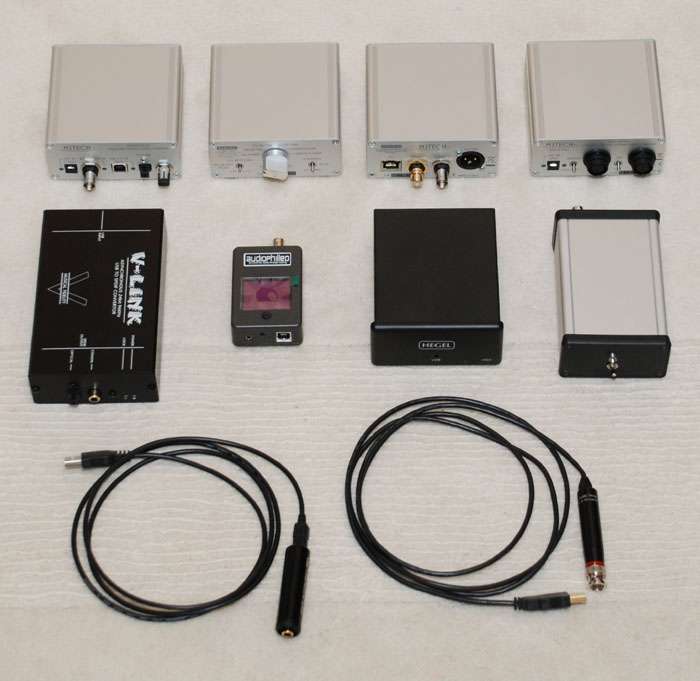 Here is the complete list of converters I tried (from the cheapest to the most expensive one): Matrix USB 24/96 - $59 Musical Fidelity V-Link II - $199 Hegel HD2 - $350 (this primarly an USB DAC but can be also used as standalone USB/SPDIF converter) Halide Design The Bridge - $399 JK SPDIF Mk3 - $436 (335 EURO) Stello U3 - $495 M2Tech HiFace Evo - $499 Audiophilleo 1/2 -$579/$979 M2Tech HiFace Evo + Evo Supply - $990 M2Tech HiFace Evo + Evo Supply + Evo Clock - $1485 Berkeley Alpha USB - $1890 Empirical Audio Off Ramp Turbo 5 - $2249 (as tested, with $700 Dual Turboclock and $250 S/PDIF Hynes regulator options installed) Soulution 590 - $3000 dCS U-Clock mk1 (24/96) - $4990 All the converters were tested on my dCS Scarlatti and Metrum Octave DACs. In the ‘second round’ of the shootout, I have also tested them with Accuphase DC-801, Metrum HEX, Berkeley Alpha Series II and McIntosh MDA-1000 DACs. On the computer side, I was using my hi-man PC server (equipped with powerful i5 processor, fast RAM, SSD, Seasonic fanless PSU, various SOtM bits including PCI/USB SOtM card), running Win 7/64, JRMC 17 and JPlay v4.1.  The cables I used for the shootout were the excellent AudioQuest Diamond USB, Kimber D-60 RCA->BNC, dCS generic BNC to BNC cable and later on, also the Stealth Varidig Sextet AES/EBU. As a point of reference, I have used the dCS Scarlatti CD/SACD transport, with the external clocking feature disconnected (to level the playing field between the USB converters and dCS transport). Enabling the external clocking and slaving the dCS transport to the dCS DAC (or an external dCS clock) further improved the performance of the dCS transport, but for this shootout, I was interested in its SPDIF performance only. 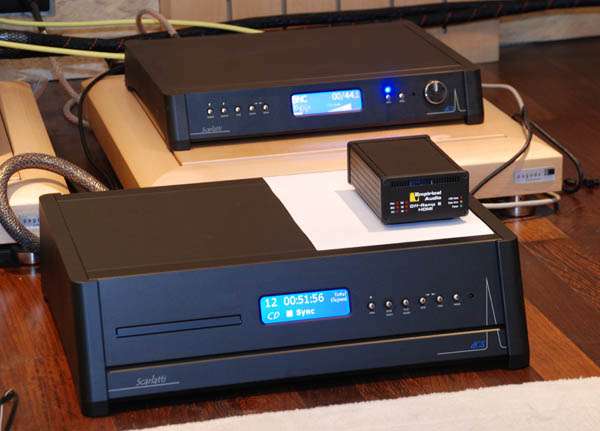 Further references included Stello CDT-100 CD transport and Bryston BDP-1 digital transport. 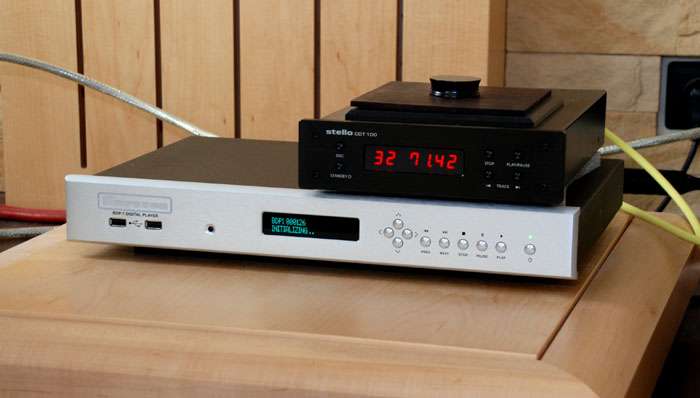 To give you a better perspective on the magnitude of differences between all of those converters, I have chosen to give every converter a simple numeric score. I’m not a big fan of any numeric scoring systems, even though German magazines like AUDIO and STEREO have been using them for years, since in my opinion, the sonic signature is just too complex to describe it using a single score. Two components may have an identical score, but have a completely different sonic flavor, and as a result – appeal to completely different people. It is not difficult to imagine a situation, where a component with a lower score, may actually be a better fit in our system, because of our preferences and/or system synergy, than a component with a higher score. However, in case of USB/SPDIF converters, where most of the changes are down to the difference in level of resolution, smoothness (where by smoothness, I mean a lack of digital glare, grain and artificial edge) and instruments layering, I thought that the numeric score could actually give you a much better idea of the differences between the respective converters. The dCS Scarlatti transport, which was used as a point of reference, was given a base score of 100 points. One of the recordings I used most often during those tests, was 'La Spagna' by Atrium Musicæ de Madrid and Gregorio Paniagua (BIS-CD-163) - a fabulous recording of XV century music. This recording has lots of percussive instruments - triangles, hi-hats etc and was recorded in a very lively acoustics and makes spotting for differences much easier. The results of the 'first round' of the shootout were as follows: Matrix 24/96 - 60 Hegel HD2 - 65 Musical Fidelity V-Link II - 75 Stello CDT-100 - 75 Bryston BDP-1 - 80 Halide Design The Bridge - 80 (+5 when powered from SOtM USB card) M2Tech HiFace Evo - 80 Stello U3 - 85 JK SPDIF Mk3 - 90 M2Tech HiFace Evo + Evo Supply - 90 Audiophilleo 1/2 - 95 Empirical Audio Off Ramp Turbo 5 - 95 M2Tech HiFace Evo + Evo Supply + Evo Clock - 100 dCS Scarlatti CD/SACD transport - 100 (+5 when used with dCS DAC and the Clock Link feature enabled) Not surprisingly, the cheapest Matrix converter was also the poorest performing of the lot. It was the most 'digital sounding', with a lot of digital glare and grain, and the poorest rendition of space - as if the whole air just got sucked out. The full Evo stack on the other hand was clearly the best, having the best resolution and HF extension, great layering of instruments and sounding very refined, ultra smooth and fluid. It was even better than Scarlatti CD/SACD transport in terms of resolution, articulation and lack of grain. It lacked a bit in terms of tonal color and texture, sounding at times a little bit lightweight and 'ethereal', but in general, they were both on the same level. Of course, the Scarlatti transport could be further improved by adding a clock link to the DAC or an external clock, but that only shows how flawed S/PDIF interface is to begin with. Other converters had fallen in between those two. Even though some of the converters got equal score, it doesn't mean they sounded exactly the same. Case in point are the ORT 5 and AP1/2 converters. Both scored 95 points, and yet, they sound a bit different. ORT5 is a bit dark sounding. You will not get the vast sound stage that AP1/2 will throw, you will miss some spatial clues and decay trails. On the positive side, ORT5 had the best texture out of all converters I tried up to that point, and was the only converter that fully matched my Scarlatti CD/SACD transport in that regard. AP has superior resolution and better microdynamics than the ORT5. If you voice your system around the AP, ORT5 will most likely sound a bit muted. That being said, in some systems AP may be too much of a good thing. Some people reported that AP sounded a bit bright in their systems. I believe this is may be computer dependent (since AP is USB powered, it relies heavily on the quality of USB power, so cards like SOtM USB with their own ultra low noise voltage regulators can help here). Both converters can be improved by adding a dedicated PSU. A friend of mine - Marcin of JPLAY fame - who borrowed ORT5 from me, reported what he called 10% improvement in SQ by substituting the supplied switch-mode wall wart PSU with his KingRex linear PSU (please note that the 10% he stated have no direct relation to my scale). Aparently, Empirical even makes their own battery PSU, called Monolitic, but it adds another $1k to the hefty price of ORT5. AP recently introduced what they call a PurePower battery PSU. This is a $449 option for both AP1 and AP2. I recently tried one, and recommend it. I felt the AP+PurePower could now rival the M2Tech 3-box solution sound wise, but it is cheaper and much less hassle - M2Tech full Evo stack comes in three boxes, a lot of extra cables, manual sample rate switching is necessary. On top of that - the battery depletes in just under 3.5h, which means that most users will need a separate power supply for the clock and the converter for any extended listening sessions, which further adds for the system cost and complexity. AP PurePower PSU lets you listen for like 15h straight, and then recharges itself via USB when you stop listening. After the ‘first round’ of my shootout, I decided to keep the Audiophilleo 1 and return/sell the rest of the converters, including the Halide Bridge, which was my old reference. As much as I wanted to go with the M2Tech full stack, the lack of userfrendliness of that setup was a show stopper for me. Plus, the AP1 offered a host of additional features, making it completely unique among USB/SPDIF converters - full function digital preamp, remote control, display showing sample rates, to name only a few. ***** A few weeks after completing the ‘first round’ of my shootout, I managed to borrow two very expensive USB/SPDIF converters that I always wanted to try, but wasn't able to secure on time for the shootout - dCS Puccini U-Clock and Soulution 590. At $4990 and $3000 respectively, they are one of the most expensive converters available on the market today. They were not bad, but M2Tech stack was still better – and much cheaper (if pita to use). 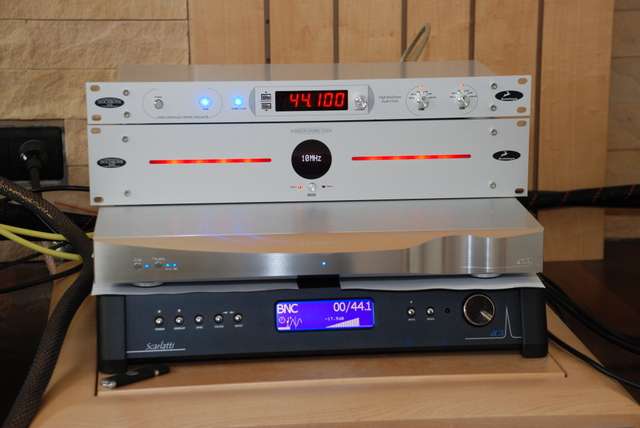 Around the same time, Peter from Audiophilleo sent me a Pure Power battery PSU for my AP1. It made the AP sound smoother, with slightly better color density and even better soundstaging that the plain vanilla AP. If I was asked to expend the ranking to include those 3 new converters, I would award them with the following score: Matrix 24/96 - 60 Hegel HD2 - 65 Musical Fidelity V-Link II - 75 Stello CDT-100 - 75 Bryston BDP-1 - 80 Halide Design The Bridge – 80 (+5 when powered from SOtM USB card) M2Tech HiFace Evo - 80 Stello U3 - 85 JK SPDIF Mk3 - 90 M2Tech HiFace Evo + Evo Supply - 90 Soulution 590 – 90 (+5 when powered from SOtM USB card) Audiophilleo 1/2 - 95 dCS U-Clock - 95 (+5 when used with dCS DAC and the Clock Link feature enabled) Empirical Audio Off Ramp Turbo 5 - 95 AP1 with the PurePower battery PSU - 95 (borderline 100) M2Tech HiFace Evo + Evo Supply + Evo Clock - 100 dCS Scarlatti CD/SACD transport - 100 (+5 when used with dCS DAC and the Clock Link feature enabled) At that point, I decided to stop the search for the ultimate USB/SPDIF converter. After trying 14 different designs from all price points, I simply felt that there is nothing that could surprise me anymore. As it later turned out - I was wrong ! During a dinner I had with Chris Connaker on his trip to Europe in November, Chris suggested me to try the Berkeley Alpha USB he reviewed for Computer Audio. He also offered me a help in contacting Berkeley people, as my first attempts a few months earlier were unsuccessful (there is no Berkeley distributor in Poland). 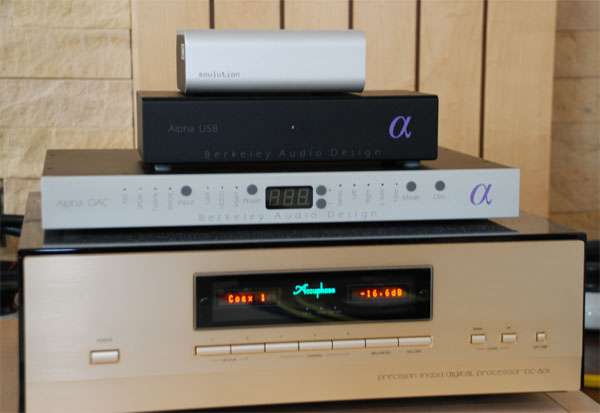 Berkeley Alpha USB showed up a few weeks later at my doorsteps, and literally – had blown me away, both with its sonics and quality of engineering behind this product. Let’s start with the engineering part first. I haven’t seen another USB/SPDIF converter, designed with this level of attention to details. The whole converter is divided into two parts - 'dirty' part (on the right) fed from the USB power, containing the XMOS USB receiver chip, and 'clean' part, fed from the onboard linear PSU, containing the clocks and SPDIF out.  Alpha USB is based on the the XMOS chip. The little 24M crystal oscillator above it (X101) is there just to make USB work.  The 'dirty' and 'clean' sides are both isolated by a chip. The lettering on the chip was removed, but I’m pretty sure this is the ADuM* chip, isolating the I2S lines between the XMOS chip and the SPDIF output. *The ADuM chips are digital isolators based on the Analog Devices, Inc., iCoupler® technology. Combining high speed CMOS and monolithic transformer technologies, these isolation components provide outstanding performance characteristics superior to alternatives, such as optocouplers.  The chip is screened by an unusual ferrite 'gate' - this is the first time I see such an arrangement in any hifi product. The 'gate' forms a 'ring' that screens the chip 360' (over and below the PCB): 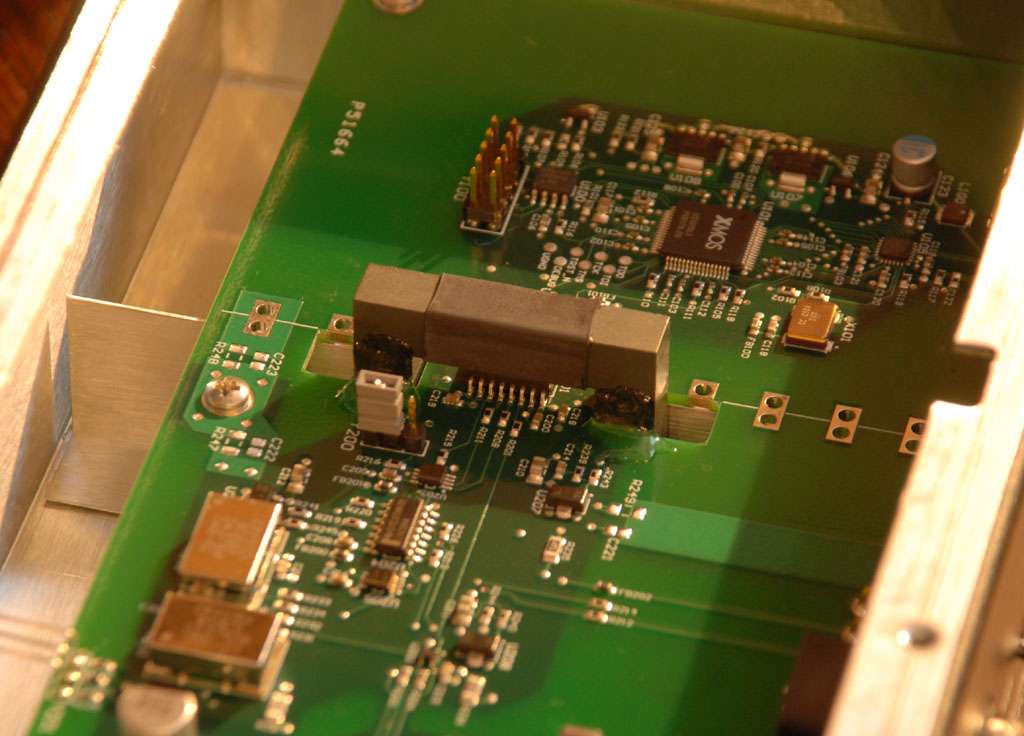 A metal screen further improves the isolation by dividing the internal volume into two compartments: 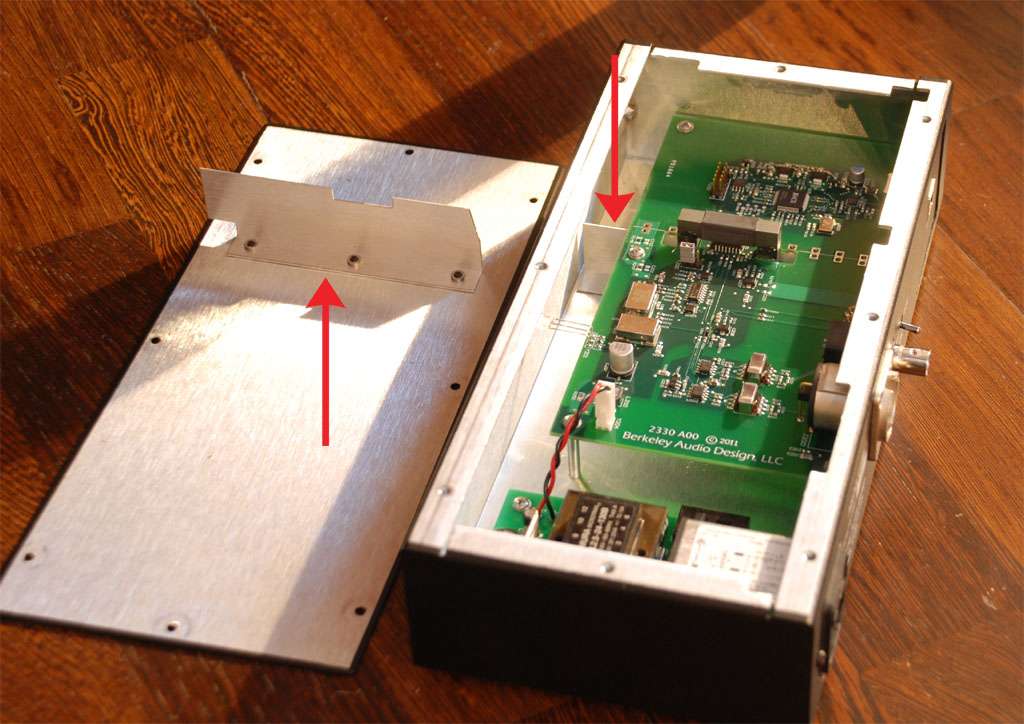 Clocks used come from Crystek - this is an ultra low phase noise design, one of the best - if not the best - currently available. From the outside they look like CCHD-957 model (also used in the Off Ramp Turbo 5, with the $700 Ultraclock option), but the markings say otherwise. They may be custom made for BADA, who knows. 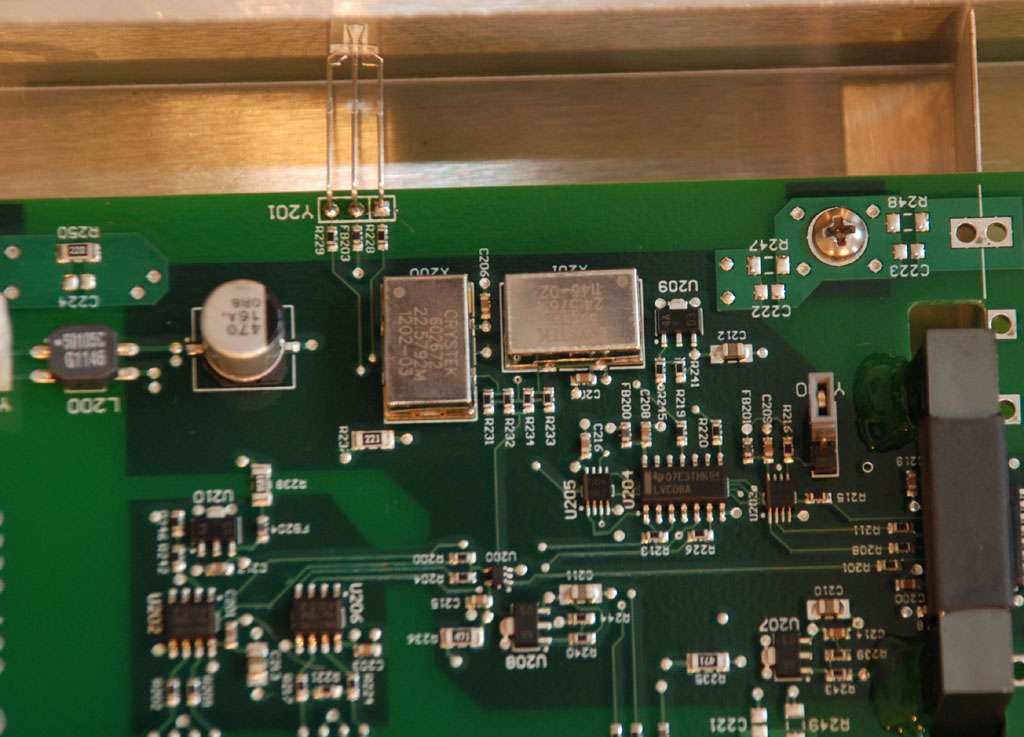 Digital output transformers have the word quality written all over them:  One of the coolest design details of Alpha USB is the way the USB input is mounted. 99.99% manufacturers make a suitable hole in the metal enclosure and mount there the USB input. Not the Berkeley. They made the 1 by 1 inch cutout in the metal enclosure, and surrounded the USB input by plastic in order to reduce the possible capacitive coupling between the two. How clever ! 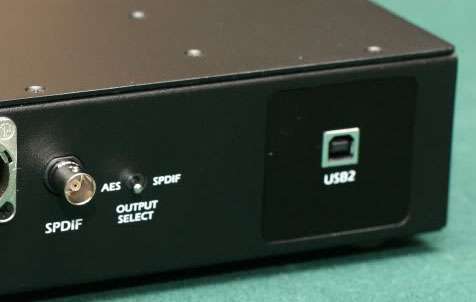 Sound wise – this is by far the best sounding USB/SPDIF converter I tried, better than the dCS Scarlatti transport. The other top converters were very, very good, but still not perfect. M2Tech stack for example, has a very distinctive sound. I would describe it as ethereal - great resolution, smoothness and vast soundstaging, but at the same time it is a bit light on its feet, lacking some substance and midrange texture. ORT5 on the other hand sounds warmer, fuller with more texture, but at the same time, lacks the top end resolution and extension that Evo (and to lesser extent the Scarlatti transport) is capable of. You can say that BADA is best of both worlds, and then some. Alpha USB has all the texture of the ORT5 and Scarlatti transport, but combines that with the outstanding resolution, smoothness and soundstaging of the Evo stack. In fact, it even goes one step further that the Evo in that department - with BADA not only you can hear all the detail, but you can actually feel a sound wave developing and moving the air, which makes the instrument outlines more 3D. Quite frankly, I was stunned when I first heard this. The BADA Alpha USB made the sound smoother, with ZERO artificial edge, grain or digital glare. There was also much better layering of instruments, and air around the outlines. The instruments sounded not only better separated in space, but also much more 3-dimensional. The resolution also improved quite a bit. You could hear the sounds that you were not aware are on the recording, the HF decays had much longer trails and hung in space much longer. The most fascinating thing was that sound had better resolution, but at the same time, was so much smoother and fluid. Usually, it is another way round. Very often we try a new component or a cable and at first are fascinated by improved resolution, only to find out a few days later (after we had X-rayed all our recordings), that the increased resolution brings listener fatigue and makes the listening far less enjoyable. Not this time. BADA pulls this incredible trick of sounding both more resolute, more transparent, and much smoother at the same time. To me Berkeley Audio Designs Alpha USB defines the current state of the art in USB/SPDIF converters design. The final shootout score is as follows: Matrix 24/96 - 60 Hegel HD2 - 65 Musical Fidelity V-Link II - 75 Stello CDT-100 - 75 Bryston BDP-1 - 80 Halide Design The Bridge – 80 (+5 when powered from SOtM USB card) M2Tech HiFace Evo - 80 Stello U3 - 85 JK SPDIF Mk3 - 90 M2Tech HiFace Evo + Evo Supply - 90 Soulution 590 – 90 (+5 when powered from SOtM USB card) Audiophilleo 1/2 - 95 dCS U-Clock - 95 (+5 when used with dCS DAC and the Clock Link feature enabled) Empirical Audio Off Ramp Turbo 5 - 95 AP1 with the PurePower battery PSU - 95 (borderline 100) M2Tech HiFace Evo + Evo Supply + Evo Clock - 100 dCS Scarlatti CD/SACD transport - 100 (+5 when used with dCS DAC and the Clock Link feature enabled) Berkeley Audio Designs Alpha USB – 110 |
|
#2
|
|||
|
|||
|
Some final thoughts:
The value for money for each converter will depend on the fact if it needs USB and SPDIF cables or not. Halide Bridge converter for example, apart from the fact that it was the most bullet-proof design of all converters tested, comes with a built in USB cable and doesn't need a SPDIF one - that is easily a $200 saving. Same for the AP1. On the other hand, the BADA Alpha USB needs both cables, and in the setup I tested it with ($600 AQ Diamond USB + $600 D-60 SPDIF cable) is over $3k. This is 3x as much as the AP2 + PP (AP2 is the same as AP1, but with less features) which can be had for $1k. Please take this ranking with a grain of salt though. First of all, the converters were tested with my Metrum Ocatve and dCS Scarlatti DAC, and my hi-man music server. Since converters are a bit system dependent, you may come to different conclusions (although I doubt the differences would be greater than +/- 5 marks). Secondly, the converters can sound very different to each other (I already explained that in case of ORT5 and AP1, which both scored 95 but sound very different; the other pair that sounded slightly different were M2Tech stack and Scarlatti transport), so sometimes a converter with a slightly lower score may be a better fit in your system. |
|
#3
|
|||
|
|||
|
Very interesting Adam, and thanks for the great write up.
I can only comment on the Berkeley and Soulution, and I would flip your results, especially when using the 590 with a Soulution CD/SACD player. As usual, there's a synergy when using components from one manufacturer. I found both to be excellent, however, and my choice is more about personal preference than absolute sound quality. |
|
#4
|
|||
|
|||
|
Do you use the Clock Link feature between the Soulution 590 and your Solution CDP ?
|
|
#5
|
||||
|
||||
 Adam....I'm a big fan of reclockers, I found this review extremely interesting. Nothing better than reading most A game players in one comparison. Thank you very much for taking the time to do it and sharing it. 
|
|
#6
|
|||
|
|||
|
Hi Adam,
I don't own the Soulution CD player I used during the demo against the Berkeley. I'm also not familiar with the Clock Link feature. Jon |
|
#7
|
||||
|
||||
|
Adam... Thanks for taking the time to post this detailed review and pics.

__________________
Ivan FLORIDA MX136, MC1.2KW(10) MC2KW(2), MCD1100, MS750(2) MVP881, C1000C/P/T, MPC1500, HT-2 SUBS(2) HT3F(2) WS350(2) XRT2K, XCS2K, XR27(2) XCS350(2) JL GOTHAM v2 SUBS(2) SILENZIO MUSIC SERVER, LUMAGEN RADIANCE SCALER, SONY VPH-G90U 4K PROJECTOR, STEWART 120" MOTORIZED SCREEN, CINEMA-TECH SEATING, WW PLATINUM CABLES Reference System: ACCUPHASE A300 AMPS, C3900 PRE-AMP, DP1000 CD/SACD TRANSPORT, DC1000 DIGITAL PROCESSOR, DG-68 DIGITAL EQUALIZER, T1200 FM STEREO TUNER, PS1230 POWER SUPPLY, HRS-SXR CUSTOM RACK w/ M3X SHELVES, TAD REFERENCE ONE MK2 LOUDSPEAKERS, WW PLATINUM CABLES CAPE COD MX150, MC501(2) MC1.2KW(10) MC2301(2) MR88, MVP881, MCD1100, MDA1000, C1000C/P/T, MPC1500, ESOTERIC K-01X 30th ANNIVERSARY (BLACK) SACD/CD PLAYER, G02-X CLOCK, HT3F(2) XRT2K, XCS2K, XR27(2) JL GOTHAM v2 SUBS(2) JL FATHOM F113v2 SUBS(4) SOUND ANCHOR STANDS(2) KALEIDESCAPE STRATO & TERRA SERVERS 80-TB, LUMAGEN RADIANCE SCALER, SONY VPH-G90U 4K PROJECTOR, STEWART 120" SCREEN, SONUS FABER STRADIVARI, SILENZIO MUSIC SERVER, FORTRESS SEATING, WW PLATINUM CABLES Analog Rig: CLEARAUDIO INNOVATION WOOD, UNIVERSAL ARM w/ Da VINCI' CART, 2nd UNIVERSAL ARM w/ GOLDFINGER STATEMENT CART, HRS-MXR REFERENCE RACK-GLOSS BLACK w/ M3X SHELVES, AESTHETIX RHEA SIG PHONO-PRE, BRYSTON BHA-1 HEADPHONE AMP, WW PLATINUM CABLES Reference System: BURMESTER 911MK3 AMP(3), 088 PRE-AMP, 089 CD PLAYER, 100 PHONO PRE-AMP, 948 POWER CONDITIONER, ACCUPHASE DG-68 VOICING EQUALIZER, AVID ACUTUS REFERENCE SP TT, GRAHAM PHANTOM II SUPREME ARM, BENZ MICRO LP-S CART, GRANDIOSO P1X/D1X STACK, G1X RUBIDIUM MASTER CLOCK, N05 NETWORK PLAYER, SILENZIO MUSIC SERVER, HRS-SXR CUSTOM RACK w/ M3X SHELVES, SONUS FABER AIDA SPEAKERS, JL FATHOM F113v2 SUBS(2) SOUND ANCHOR STANDS(2) WW PLATINUM CABLES Library System: GRANDIOSO M1 MONOBLOCK AMPS, C1 LINESTAGE PRE-AMP, K1X CD/SACD PLAYER, G1 MASTER RUBIDIUM CLOCK, E02 PHONO-PRE, SILENZIO MUSIC SERVER, AERIAL ACOUSTICS 20T V2, AERIAL SW12 SUBS(2), CANTON REF K1’s, VPI HRX TT w/ SDS POWER SUPPLY, ORTOFON CADENZA BLACK CART, KLAUDIO RCM, SHUNYATA DENALI 6000/S v2, SHUNYATA OMEGA QR’s, WW PLATINUM CABLES Esoteric/Bryston System: ESOTERIC C02-X PRE-AMP, P-02X TRANSPORT, D02-X DAC, G02-X CLOCK, BRYSTON 28B3 CUBED MONOBLOCK AMPS(4), BRYSTON BHA-1 HEADPHONE AMP, SHUNYATA DENALI 6000/S v2(2) EVEREST 8000 POWER CONDITIONER(2) ALTAIRA CG & SG HUBS, AMR-DP777-SE DAC, SILENZIO MUSIC SERVER, TAD REFERENCE ONE MK2 LOUDSPEAKERS, QUADRASPIRE RACK, WW PLATINUM CABLES Accuphase/Canton System: ACCUPHASE E800 INTEGRATED, DP570 CD/SACD PLAYER, T1200 FM STEREO TUNER, DG-68 VOICING EQUALIZER, PS530 POWER SUPPLY, CANTON REF K3’s, CANTON REF K5’s, SILENZIO MUSIC SERVER, HRS MXR REFERENCE MAHOGHANY RACK w/ M3X2 SHELVES, WW GOLD CABLES |
|
#8
|
|||
|
|||
|
Great review Adam, and on a tricky subject. Many thanks for posting!
|
|
#9
|
|||
|
|||
|
Forgot to add that Berkeley is not easy to buy in the EU because it is not RoHS compliant. Nor will Berkeley make it so, as they believe it affects the SQ.
It can be bought by contacting the Swiss distributor. |
|
#10
|
||||
|
||||
|
One thing I'd like to add/clarify to some readers is that USB/SPDIF converters are called, well, USB/SPDIF converter. I prefer the name reclockers, or master clocks. Yes, they do convert the signal to SPDIF from USB, but I don't see that as it's main function. The most important job it does is reclocking the signal and outputting an ultra low jitter signal that results in a significant audible improvement in sound quality. With exception to some really top dog DACs, the clocks on these converters easily beat the one's on the DAC.
|
 |
|
|
| Audio Aficionado Sponsors | |